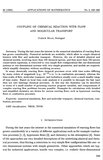Article
Full entry |
 PDF
(2.2 MB)
Feedback
PDF
(2.2 MB)
Feedback
 PDF
(2.2 MB)
Feedback
PDF
(2.2 MB)
Feedback
Keywords:
numerical simulation; flow and molecular transport; chemical reactions; combustion processes
numerical simulation; flow and molecular transport; chemical reactions; combustion processes
Summary:
During the last years the interest in the numerical simulation of reacting flows has grown considerably. Numerical methods are available, which allow to couple chemical kinetics with flow and molecular transport. However, the use of detailed physical and chemical models, involving more than 100 chemical species, and thus more than 100 species conservation equations, is restricted to very simple flow configurations like one-dimensional systems or two-dimensional systems with very simple geometries, and models are required, which simplify chemistry without sacrificing accuracy. In many chemically reacting flows chemical processes occur with time scales differing by many orders of magnitude (e.g., 10$^{-10}$ s to 1 s in combustion processes), whereas the time scales of flow, molecular transport, and turbulence usually cover a much smaller range of time scales. Based on local time scale analyses it is possible to decouple the fast (and thus not rate limiting) chemical processes. In this way the chemistry can be described in terms of a small number of governing reaction progress variables, and computations of complex reacting flow problems become possible. Examples for calculations with detailed and simplified chemistry are shown for various reacting flows, such as hypersonic reacting flows or combustion processes.
References:
[1] Proc. Eurotrac 1994, Transport and Transformation of Pollutants in the Troposphere. Garmisch-Partenkirchen, Germany, 1994.
[2] Reduced Kinetic Mechanisms and Asymptotic Approximations for Methane-Air Flames, Lecture Notes in Physics 384. M. D. Smooke (eds.), Springer, Berlin Heidelberg New York, 1991.
[3] Reduced Kinetics Mechanisms for Applications in Combustion Systems. N. Peters, B. Rogg (eds.), Springer, Berlin, 1993.
[4] J. C. Keck: 22 $^{nd} $ Symp. (Intl.) Combustion. The Combustion Institute, Pittsburgh, 1989, p. 1705.
[5] A. S. Tomlin, M. J. Pilling, T. Turanyi, J. H. Merkin, J. Brindley: Combust. Flame. vol. 91, 1992.
[6] U. Maas, S. B. Pope: Combust. Flame. vol. 88, 1992. DOI 10.1016/0010-2180(92)90034-M
[7] U. Maas, S. B. Pope: 24 $^{th} $ Symp. (Intl.) Combustion. The Combustion Institute, Pittsburgh, 1992, p. 103.
[8] U. Maas, S. B. Pope: 25 $^{th} $ Symp. (Intl.) Combustion. The Combustion Institute, Pittsburgh, 1994, p. in print.
[9] U. Riedel, D. Schmidt, U. Maas, J. Warnatz: Laminar Flame Calculations Based on Automatically Simplified Chemical Kinetics. Proc. Eurotherm Seminar # 35, Compact Fired Heating Systems, Leuven, Belgium, 1994.
[10] A. Wölfert, M. Nau, U. Maas, J. Warnatz: University of Heidelberg, Technical Report, in print.
[11] A. Norris: The Application of PDF Methods to Turbulent Diffusion Flames. Dissertation, Cornell University, Ithaca, NY, USA, 1993.
[12] Hypersonic and High Temperature Gas Dynamics. J. D. Anderson (eds.), McGraw-Hill Book Company, New York, 1989.
[13] D. Schmidt, U. Maas, J. Warnatz: Simplifying Chemical Kinetics for the Simulation of Hypersonic Flows Using Intrinsic Low-Dimensional Manifolds. Proc. 5 $^{\mathrm th} $ International Symposium on Computational Fluid Dynamics, Sendai, Japan, 1993.
[14] J. O. Hirschfelder, C. F. Curtiss: $3^{rd} $ Symp. Comb. Flame and Explosion Phenomena. Williams and Wilkins, Baltimore, 1949.
[15] Transport Phenomena. R. E. Bird, W. E. Stewart, E. N. Lightfoot (eds.), Wiley Interscience, New York, 1960. Zbl 0089.22301
[16] U. Maas, J. Warnatz: Pure & Applied Chemistry. vol. 259, 1993, p. 65.
[17] U. Maas: Automatische Reduktion von Reaktionsmechanismen zur Simulation reaktiver Strömungen. Habilitationsschrift, Universität Stuttgart, 1993.
[18] U. Maas: Publication in preparation.
[19] Hypersonics, Volume I – Defining the Hypersonic Environment. J. J. Bertin, R. Glowinski, J. Periaux (eds.), Birkhäuser, Boston, 1989. MR 1000781
[20] U. Riedel, W. Maas, J. Warnatz: IMPACT Comput. Sci. Eng. vol. 20, 1993. DOI 10.1006/icse.1993.1002
[21] C. Park: AIAA Paper 85–0247 (1985).
[22] C. Weiland: Journal of Computational Physics 102 (1992), 319–335. DOI 10.1016/0021-9991(92)90375-9 | MR 1187692 | Zbl 0759.76052
[23] M. Pfitzner: AIAA Paper. (1991), 91-1467.

